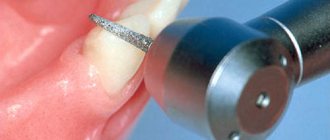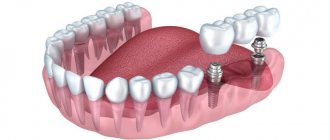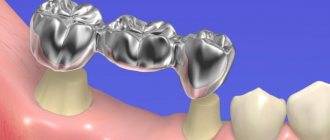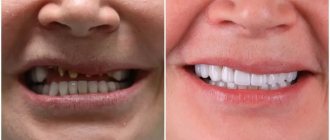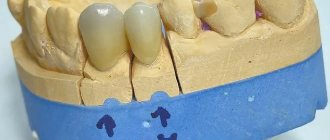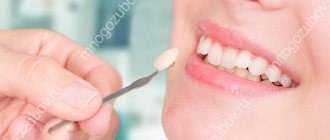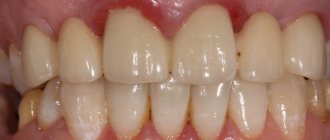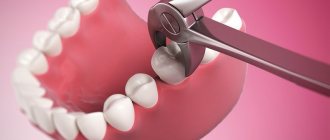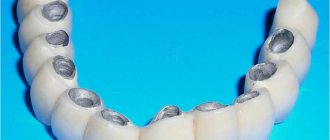- Home » Articles » Is it necessary to depulp a tooth under a crown?
14 September 2021
A dental crown is a prosthetic solution that allows the restoration of severely damaged teeth in situations where reconstruction cannot be performed with a composite material. Crowns can be made of metal ceramics, solid ceramics or zirconium (the most popular options). But they have one thing in common: a properly made crown can serve patients as long as a natural tooth. And the basis of proper manufacturing is proper preparation for prosthetics.
How we do it at Amazing Price Dentistry:
PROMOTION
Dental restoration, installation of fillings
from 2200 rub.
Cost of tooth depulpation (depulpation)
How much does it cost to depulp an upper front or lower back tooth?
The cost of tooth removal in Moscow on a turnkey basis depends on the following factors:
- microscope applications
- dentist qualifications
- pricing policy of the dental clinic.
- High-quality dentistry in Moscow
- Israeli Adin implants
- All-on-4 dental implantation
- All-on-6 implantation
- Israeli implants Alpha Bio
- Alternative to Dental Implants
- American dental implants
- German Ankylos implants
- Dental implantation for bone tissue atrophy
- Basal dental implantation
- Partial dental implantation
- Professional cleaning of dental implants
- Cleaning your teeth before installing implants
- Dental implantation or dentures: which is better?
- Korean Dentium implants
- Cheap dental implants
- Two-stage dental implantation
- Express dental implantation
- German ICX implants
Request a call back or dial our number!
+7
This phone call does not obligate you to anything. Just give us a chance and we will help you!
Just pick up the phone and call us!
+7
We will definitely make you an offer that you cannot refuse!
When to place crowns on worn teeth
Increased tooth wear
is a rapid deformation of the crown part of the tooth. Signs of the presence of the disease: noticeable changes in the shape and size of the crown, the appearance of increased sensitivity of the teeth, malocclusion, chips and cracks. See how in this clinical example:
There can be many reasons for the occurrence of the disease - both manifestations of congenital pathology and acquired during life.
Diagnosis and treatment are preceded by a thorough examination using various diagnostic equipment. Treatment is carried out individually, where, along with other methods, orthopedic structures can be used - mouth guards, crowns, veneers, bridges, and so on. But the result of treatment should always please both the patient and his attending physician:
A timely installed crown on a tooth means an attractive smile and full functionality of the teeth. The main thing is to strictly follow the doctor’s recommendations regarding the care of dentures, and then the question: “How long should it take to change the crowns on the teeth?” will not arise for quite a long time.
Installing a crown on the sixth tooth
Contrary to popular belief, the first permanent teeth that emerge in humans are molars (we call them sixes). They bear the main chewing load. Due to some reasons: poor hygiene or lack of it at all, untimely treatment, and so on, caries forms and, as a result, tooth decay.
Filling a tooth with a high functional load is not cost-effective and ineffective. Chewing hard foods can cause fillings and tooth walls to crack. Therefore, the best option is to install a crown. It will completely restore the chewing function of the tooth and protect it from further destruction.
The method of prosthetics for the sixth tooth depends on the clinical picture, and the decision is made by the orthopedist. If the tooth decay is severe, then I usually recommend removing the molar and then installing a pin onto which the crown is attached.
If the tooth can be saved, then prosthetics occurs according to the following algorithm:
- Inspection and diagnostics.
- Complete sanitation of the oral cavity is a mandatory procedure, the implementation of which determines the quality of prosthetics. The slightest presence of infection in the patient’s mouth can provoke the emergence of infectious foci in the prosthetic area.
- Tooth preparation, impression taking.
- Fixation of a permanent crown.
Some people think that it is possible to expect the production of a prosthesis with grinded teeth without temporary plastic crowns - such as as long as it takes, if you do not eat too hard food. No and no again! The ground tooth/teeth must be covered with temporary crowns! Typically, the waiting time for permanent crowns and wearing temporary ones is one to two weeks.
When choosing a material for a prosthesis, you need to take into account: where you want to place the crown and the functional feature of the tooth, therefore, to create a crown for the sixth tooth, it is better to use a material with high strength values.
Recommended material for a crown on a living tooth
The choice of material depends on which teeth the crown will be installed on. High-quality dentures look more aesthetically pleasing and will last longer, so there is no need to save on cost.
- Metal ceramics. Modern dentistry rarely uses this material due to the need to remove a thick layer of enamel. Doctors prefer metal-free structures for prosthetics of a living tooth and after depulpation.
- Ceramics. Ceramic crowns are difficult to distinguish from natural teeth. They are light and imperceptible to use. Suitable even for allergy sufferers. Ceramic crowns are not placed on chewing teeth.
- Zirconium dioxide. Strong and durable material that lasts up to 20 years. Its cost is slightly more expensive than ceramics, but zirconium dioxide is indispensable for back teeth.
The dental clinic "Carmen-Med" in Nizhny Novgorod specializes in prosthetics of any complexity. Already at the first consultation, the doctor will draw conclusions about the need to depulpate or preserve the nerve before installing a crown.
Nerve removal before dental prosthetics
Dental prosthetics is a long process that requires a preparatory stage. After the decision is made to restore the dentition and place crowns, preparation is carried out. It includes grinding the tooth and removing the nerve.
Removing a nerve before dental prosthetics is a procedure, the feasibility of which is determined by the dentist in each case individually. Depulpation has several features and is tolerated differently by patients. If pain persists after the procedure, then it is necessary to postpone prosthetics and wait until the pain completely disappears.
Why is depulpation necessary?
The procedure is prescribed in most cases because it has several features. After removing the nerve, the development of pulpitis is prevented. If the pulp becomes inflamed, the patient will need to have the crown removed and the tooth cavity opened, which causes a lot of trouble and discomfort. When the nerve is removed, the cavity is filled with a special material to install a filling. There are the following indications, in the event of which the nerve is removed before dental prosthetics:
- anatomical malposition of the tooth;
- deep and widespread caries, including on the roots;
- low landing of the crown;
- the need for emergency opening of the pulp chamber for subsequent treatment of the tooth;
- acute pulpitis;
- periodontitis.
If other factors are present, the dentist decides individually how much nerve removal is necessary. A big controversy is most often caused by healthy teeth, which merely serve as supports when installing bridges. It should be noted that in modern dentistry, it is not the installation of a crown that is an indication for nerve removal, but rather the opposite, if a nerve had to be removed, it is recommended to cover the tooth with a crown. This is due to the fact that the enamel darkens, loses its protective properties and becomes vulnerable to various external factors. To preserve a tooth, it must be covered with a shell.
Removal of the nerve before dental prosthetics is carried out in several stages. First, anesthesia is administered, then the root canal is exposed, and the pulp and soft tissue are removed. After this, the canals are filled and the original shape of the tooth is restored with filling material. Only after completing these steps can you begin denture prosthetics.
Do I need to depulp my teeth before installing crowns or bridges?
Short answer: in 99% of cases, when the tooth is correctly positioned in the dentition, this is not necessary. Very rarely (if there is a significant tilt or protrusion of the tooth, when the artificial crown does not repeat the previous shape, but corrects it) it is necessary to remove the pulp.
This issue in developed countries was resolved in the last century. However, in Russia the opinion still prevails among doctors and patients that depulpation under the crown is always necessary, or at least in most cases. Many articles on the Internet popularly explain why this is practiced. Let's look at the arguments of dentists who support depulpation, point by point.
1. A living tooth may then become ill under the crown at the most inopportune moment.
The funniest argument ever. But a living tooth with a filling can’t get sick later? Maybe. Then it is necessary to depulpate it too to prevent future pain. But just a living tooth, completely intact, can also become infected with caries in a couple of years and get sick. According to this logic, all healthy teeth should be preventively depulped. By the way, you don’t have to stop at your teeth - your leg, kidney, or head can also get sick in the future, and also at the most inopportune moment. Would patients agree to have these organs amputated now to avoid potential pain in the future? But for some reason they agree to remove the tooth pulp...
2. If the vital tooth under the crown hurts, the crown will have to be sawed, not only treatment will be required, but also re-prosthetics. This is financially expensive and aggravates the conflict situation with the patient.
Firstly, it is not at all necessary to redo the crown. A hole is carefully drilled on the chewing or lingual (near the front teeth), the canals are treated, then the endodontic access is also carefully filled with filling material. There is no significant reduction in the mechanical strength of the crown. Aesthetically, some dissonance may arise, but for others it will not be noticeable at all. In the current age of implantation, half of the crowns on implants are fixed with a screw fixation, which ends with the same filling in the middle of the ceramic crown. This does not bother patients, and orthopedic dentists initially plan for such a “leaky” crown. Secondly, the probability of a preventively pulpless tooth getting sick under a crown is no lower, even higher. And it will be much more difficult or simply impossible to treat it later (it will all end with tooth extraction). The reason is that it is often necessary to reinforce the tooth after depulpation with pins or core inlays. But getting them is far from easy, and as a result of such extraction, so little healthy tissue may remain from the tooth that it will not be possible to save it.
3. Under the crown (most often a metal-ceramic crown appears) it is necessary to grind off a lot of enamel and dentin - the pulp located in the center of the tooth will be damaged and inflamed.
There is no need to over-prepare the teeth, leaving only matchsticks - and the problem will disappear. The less hard tooth tissue is removed, the more qualified the doctor and dental technician are. The best specialists are able to perform excellent work with a thickness of 0.5 - 1 mm. Crowns 1-1.5 mm thick are also an acceptable option that does not require depulpation. But if you remove 2 mm or more from each side of the tooth, then, of course, you will catch the pulp and it is better to get rid of it in advance.
4. Even if the pulp is not damaged directly during grinding, due to a thermal burn (occurring during tooth preparation), it will still suffer, become necrotic, and sooner or later the tooth will hurt/a cyst will grow.
If you operate without water cooling or with insufficient cooling, there is a risk of thermal burns. Some doctors do not like working with a water spray: splashes fly in all directions and visualization deteriorates. However, this is a violation of the orthopedic treatment protocol. It is recommended for use in the same way as compliance with sanitary requirements. If this is observed, overheating of the pulp will not occur. However, a 2002 study by American authors found that even in the absence of water cooling, the failure rate among living teeth prepared without water cooling in the 1970s was 2.19%, and in the 1980s - 0.66%. That is, the problem of the risk of thermal burn of the pulp is clearly exaggerated. https://www.ncbi.nlm.nih.gov/pubmed/12473995
5. During preparation, dentinal tubules are exposed - through them, bacteria will make their way to the pulp and cause its inflammation.
This will happen if bacteria are given this opportunity. If the crown is made precisely, the distance between it and the dentin of the tooth is minimal, and it is also filled with a decent cement material - the chances of microbes will be as small as when placing a filling. No one depulps teeth before filling as a preventive measure, although more dentinal tubules may be exposed there than during crowning. Yes, and it is mandatory to make and cement a temporary crown immediately after preparation and impression taking. To completely prevent bacterial invasion, some qualified dentists seal the dentinal tubules with special preparations.
6. Crowns are rarely placed on completely healthy teeth. If the tooth already had a large filling or there was deep caries, then the pulp is no longer healthy. Grinding under a crown is an additional stress for it; the risk of inflammation and necrosis in such teeth is high, so depulpation is completely justified.
In fact, with a significant size of the carious cavity, the pulp of a living tooth, resisting bacterial toxins, builds replacement dentin inside its pulp chamber. Thereby obliterating the dentinal tubules and reducing the strength of external negative influences, one of which is indeed tooth preparation. That is, the risk of mechanical or thermal damage to the pulp is reduced. But the likelihood of unsuccessful endodontic treatment in such teeth, on the contrary, increases. Since obliterated canals are more difficult to process and expand, denticles may form in the tooth, which also complicates root canal treatment.
7. Theoretically, there is no need to depulp teeth, but my experience and the long-term experience of my colleagues shows that problems arise more often with living teeth.
Let's see what scientific research says about this.
An analysis carried out by Scottish colleagues revealed that in pre-pulpless teeth before prosthetics, signs of periradicular problems were identified in 50.8% of cases, in vital teeth - only in 19%. https://www.ncbi.nlm.nih.gov/pubmed/9744239
Another study by Norwegian authors recorded a 92% success rate for wearing crowns on living teeth 10 years after their installation and 83% after 25 years. https://www.ncbi.nlm.nih.gov/pubmed/9105139
But an analysis by researchers from Hong Kong showed slightly less favorable results. The survival rate of the vital pulp under single metal-ceramic crowns after 10 years is 84.4%, after 15 years - 81.2%. The survival rate of pulp under bridges is 70.8% after 10 years, 66.2% after 15 years. https://www.ncbi.nlm.nih.gov/pubmed/16011770
Based on these data, it can be assumed that the result of successful prosthetics of vital teeth depends not least on the qualifications of dentists. Therefore, doctors who refer to their own negative experiences and the experiences of other colleagues can be completely honest. The Russian dental school and the average level of training of domestic specialists is inferior to the level of Hong Kong. But we also have doctors who meet the highest world standards. For them, preventive depulpation of teeth under a crown is the same nonsense as prescribing Corvalol for a cardiologist or Oscillococcinum for a phthisiatrician.
Thus, the recommendation to remove the pulp of teeth before prosthetics is a frank recognition by the dentist of the level of his qualifications. A fairly simple and convenient hint for a patient looking for a good dentist. A much more accurate selection criterion than academic degrees, titles and diplomas gathering dust on the wall or sparkling on Internet pages.
The importance of prosthetics
The main reason for refusals to install dentures is associated with the erroneous opinion of old-school dentists about the mandatory depulpation (removal of the nerve) of teeth before prosthetics. Before dispelling this myth, it is necessary to recall the importance of timely prosthetics.
Without an adequate prosthesis, neighboring healthy teeth begin to carry an unusual load, which leads to their increased wear, mobility and early loss. In addition, in the absence of even one tooth, speech defects appear, chewing functions are disrupted, bite pathologies occur, and even facial proportions are distorted.
Causes of frequent depulpations
Why do orthopedists so often remove pulp from teeth? The main reason lies in the desire of doctors to play it safe and avoid complications after prosthetics. The fact is that teeth have a porous structure. Pores are dentinal canals that run from the enamel to the pulp of the tooth. During grinding of teeth for a crown, mechanical irritation of the pulp may occur through these dentinal canals.
And at the last stage of fixing the prosthesis, there is a toxic effect of cement. And as a result - infection and death of the pulp. However, this does not allow us to consider depulpation as a prevention of complications, since this procedure is inevitably associated with the risk of developing periodontal pathologies. After all, no one suggests removing the appendicitis for preventive purposes. Living teeth retain their stability much longer.
Whereas teeth subjected to depulpation become extremely fragile and are more susceptible to destruction, losing their shock-absorbing function.
Why cover a pulpless tooth with a crown?
When a patient who came to just get a filling hears from the dentist that it is recommended to cover the tooth with a crown, he is overcome with horror! After all, a crown is already an adult thing, it is no longer just a filling or restoration, in its essence it is already a prosthesis. And what kind of prosthetics can we talk about if “I just came to get a filling”? And sometimes the patient decides to consult with another doctor who offers the same thing, and then with another, and another, and another, in the hope of hearing that the tooth can simply be treated without a crown.
But things are not so simple here. If the doctor recommends covering a tooth with a crown, there are definitely indications for this. In this article we will not consider all cases. Let us touch upon only one of the most common cases - covering a pulpless tooth with a crown.
A pulpless tooth is a tooth in which the pulp (nerve) has been removed. Such a tooth is also called dead (devitalized). In addition to the nerve, the pulp also includes blood and lymphatic vessels and connective tissue. It is through the pulp that the tooth receives nutrients that provide its regenerative abilities, which a pulpless tooth does not possess at all.
The lack of regenerative abilities significantly reduces the life of a tooth. Without internal nutrition through the pulp, the tooth becomes extremely fragile. For clarity, a pulpless tooth can be compared to a dry tree - outwardly, both can have a very solid and impressive appearance, but be hollow and brittle inside.
The main risk associated with such tooth fragility is fracture or chipping. And in the case of a tooth deprived of nutrition (internal support), such chips are, as a rule, very deep, often extending under the gum. And in the case when the fracture line or chip of the tooth goes deep under the gum, it is no longer possible to restore such a tooth reliably and for a long time either with a filling or with a crown. And this is with a favorable outcome, if the tooth can, in principle, be saved after such a fracture.
But a pulpless tooth is not a death sentence at all! Yes, theoretically it can be a time bomb, but with the right approach, a pulpless tooth can last a very long time.
A competent approach in the case of a pulpless tooth includes 2 aspects:
- thoroughly treated and sealed root canals;
- mandatory (!) covering of a pulpless tooth with a crown.
The crown will protect the entire structure of the tooth (roots and remains of its coronal part) from further chipping and destruction, thereby maximizing its life, despite the actual non-viability of the pulpless tooth.
Therefore, if it so happens that you have to deal with the removal of nerves in a tooth, be sure to listen to your dentist’s recommendations regarding covering it with a crown. This is not a whim at all, but a mandatory condition for maintaining the integrity of the dentition.
Modern dentistry offers a lot of options for crowns: from the most popular metal-ceramic to the most highly aesthetic ceramic ones, the many varieties of which we will definitely talk about in one of the following articles.
Take care of your teeth and be healthy!
0
